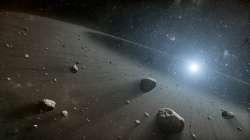In a first, NASA’s Hubble telescope observes two 'comet-like' asteroids orbiting each other between Mars and Jupiter
Understanding its origin and evolution may provide new insights into the early days of the solar system, NASA said

Astronomers have observed something rare and unusual in the asteroid belt between Mars and Jupiter. Using NASA’s Hubble Space Telescope, a group of astronomers were imaging an asteroid, designated 300163 (2006 VW139), in September 2016 just before it made its closest approach to the Sun. However, the images revealed that it was actually not one, but two asteroids of almost the same mass and size, orbiting each other at a distance of 60 miles.
What made the find interesting that the two asteroids circling together were earlier exhibiting all features of a comet – bright coma, long tail – and not an asteroid. This is possibly the first known binary asteroid, classified as a comet, and the discovery is important because the two asteroids orbiting each other make the measurement of their mass possible.
“We detected strong indications for the sublimation of water ice due to the increased solar heating — similar to how the tail of a comet is created,” explained team leader Jessica Agarwal of the Max Planck Institute for Solar System Research, Germany.
NASA said the combined features of the binary asteroid — wide separation, near-equal component size, high eccentricity orbit, and comet-like activity — also make it unique among the few known binary asteroids that have a wide separation.
“Understanding its origin and evolution may provide new insights into the early days of the solar system. Main-belt comets may help to answer how water came to a bone-dry Earth billions of years ago,” it said.
The fact that this is so different from all other known binary asteroids raises some questions about how common such systems are in the asteroid belt. “We need more theoretical and observational work, as well as more objects similar to this object, to find an answer to this question,” concluded Agarwal.
The research is presented in a paper, to be published in the journal Nature this week.
